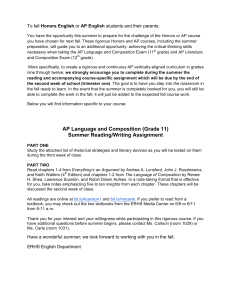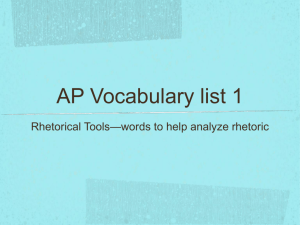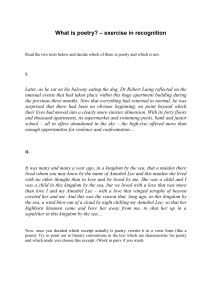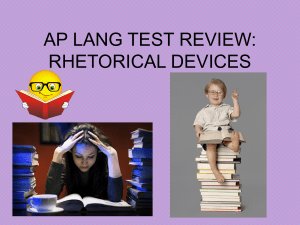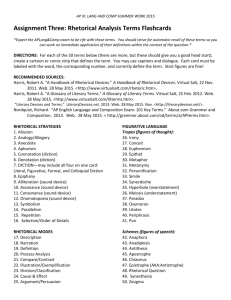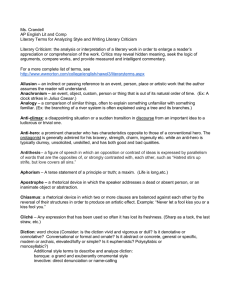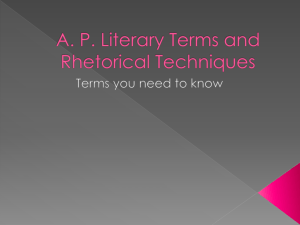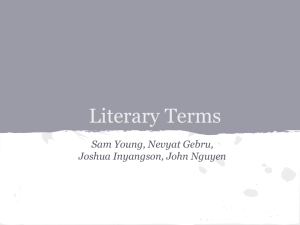Rhetorical Strategies and Stylistic Devices: Create flashcards for
advertisement
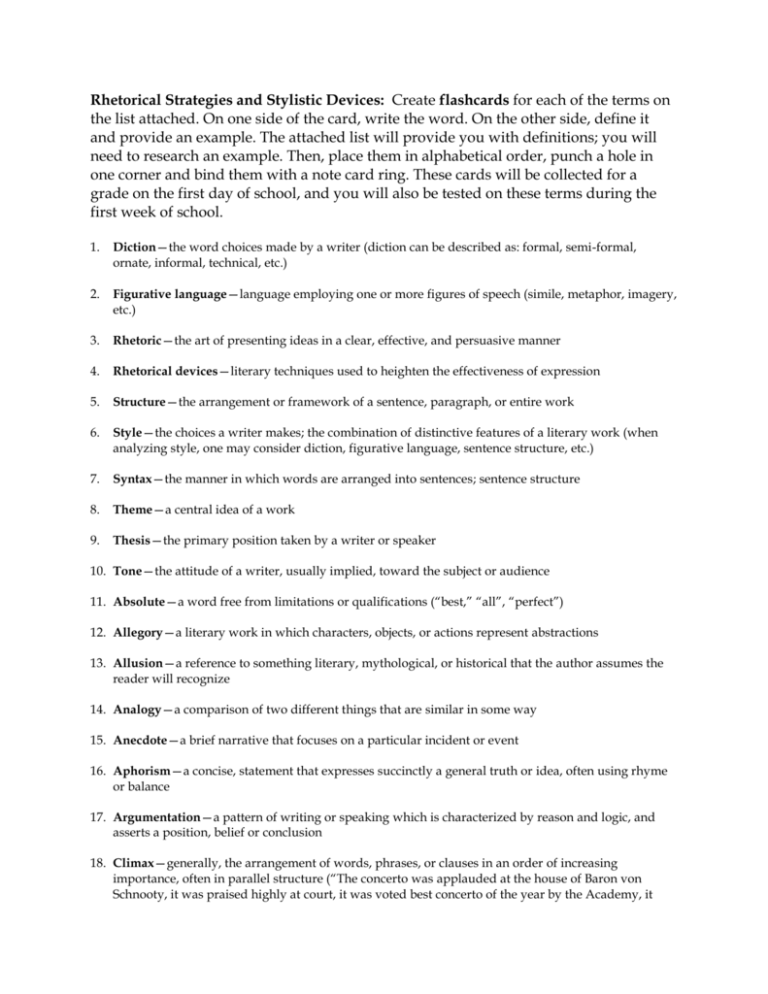
Rhetorical Strategies and Stylistic Devices: Create flashcards for each of the terms on the list attached. On one side of the card, write the word. On the other side, define it and provide an example. The attached list will provide you with definitions; you will need to research an example. Then, place them in alphabetical order, punch a hole in one corner and bind them with a note card ring. These cards will be collected for a grade on the first day of school, and you will also be tested on these terms during the first week of school. 1. Diction—the word choices made by a writer (diction can be described as: formal, semi-formal, ornate, informal, technical, etc.) 2. Figurative language—language employing one or more figures of speech (simile, metaphor, imagery, etc.) 3. Rhetoric—the art of presenting ideas in a clear, effective, and persuasive manner 4. Rhetorical devices—literary techniques used to heighten the effectiveness of expression 5. Structure—the arrangement or framework of a sentence, paragraph, or entire work 6. Style—the choices a writer makes; the combination of distinctive features of a literary work (when analyzing style, one may consider diction, figurative language, sentence structure, etc.) 7. Syntax—the manner in which words are arranged into sentences; sentence structure 8. Theme—a central idea of a work 9. Thesis—the primary position taken by a writer or speaker 10. Tone—the attitude of a writer, usually implied, toward the subject or audience 11. Absolute—a word free from limitations or qualifications (“best,” “all”, “perfect”) 12. Allegory—a literary work in which characters, objects, or actions represent abstractions 13. Allusion—a reference to something literary, mythological, or historical that the author assumes the reader will recognize 14. Analogy—a comparison of two different things that are similar in some way 15. Anecdote—a brief narrative that focuses on a particular incident or event 16. Aphorism—a concise, statement that expresses succinctly a general truth or idea, often using rhyme or balance 17. Argumentation—a pattern of writing or speaking which is characterized by reason and logic, and asserts a position, belief or conclusion 18. Climax—generally, the arrangement of words, phrases, or clauses in an order of increasing importance, often in parallel structure (“The concerto was applauded at the house of Baron von Schnooty, it was praised highly at court, it was voted best concerto of the year by the Academy, it was considered by Mozart the highlight of his career, and it has become known today as the best concerto in the world.”) 19. Colloquialism—informal words or expressions not usually acceptable in formal writing 20. Concrete details—details that relate to or describe actual, specific things or events 21. Connotation—the implied or associative meaning of a word (slender vs. skinny; cheap vs. thrifty) 22. Deductive reasoning—reasoning in which a conclusion is reached by stating a general principle and then applying that principle to a specific case (The sun rises every morning; therefore, the sun will rise on Tuesday morning.) 23. Denotation—the literal meaning of a word 24. Dialect—a variety of speech characterized by its own particular grammar or pronunciation, often associated with a particular geographical region (“Y’all” = Southern dialect) 25. Didactic statement—having the primary purpose of teaching or instructing 26. Ethos—the persuasive appeal of one’s character, or credibility 27. Euphemism—an indirect, less offensive way of saying something that is considered unpleasant 28. Hyperbole—intentional exaggeration to create an effect 29. Idiom—an expression in a given language that cannot be understood from the literal meaning of the words in the expression; or, a regional speech or dialect (“fly on the wall”, “cut to the chase”, etc.) 30. Imagery—the use of figures of speech to create vivid images that appeal to one of the senses 31. Inductive reasoning—deriving general principles from particular facts or instances (“Every cat I have ever seen has four legs; cats are four-legged animals.) 32. Inference—a conclusion on draws (infers) based on premises or evidence 33. Irony—the use of words to convey the opposite of their literal meaning; or, incongruity between what is expected and what actually occurs (situational, verbal, dramatic) 34. Jargon—the specialized language or vocabulary of a particular group or profession 35. Juxtaposition—placing two elements side by side to present a comparison or contrast 36. Logos—appeal to reason or logic 37. Maxim—a concise statement, often offering advice; an adage 38. Metaphor—a direct comparison of two different things 39. Mood—the emotional atmosphere of a work 40. Non sequitur—an inference that does not follow logically from the premises (literally, “does not follow”) 41. Paradox—an apparently contradictory statement that actually contains some truth (“Whoever loses his life, shall find it.”) 42. Parody—a humorous imitation of a serious work (Weird Al Yankovich’s songs, and the Scary Movie series are examples) 43. Pathos—the quality in a work that prompts the reader to feel pity 44. Rhetorical question—a question asked merely for rhetorical effect and not requiring an answer 45. Sarcasm—harsh, cutting language or tone intended to ridicule 46. Satire—the use of humor to emphasize human weaknesses or imperfections in social institutions (Jonathan Swift’s Gulliver’s Travels, The Simpsons, etc.) 47. Scheme—an artful deviation from the ordinary arrangement of words (anaphora, anastrophe, antithesis are some examples of schemes) 48. Trope—an artful deviation from the ordinary or principal signification of a word (hyberbole, metaphor, and personification are some examples of tropes) 49. Understatement—the deliberate representation of something as lesser in magnitude than it 50. Vernacular—the everyday speech of a particular country or region, often involving nonstandard usage

